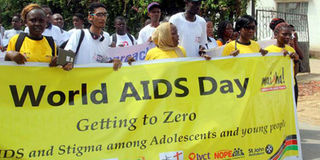Out-of-this-world goals have not hindered war on HIV pandemic

Locals during the 2015 year's World Aids Day celebration at Mombasa Technical University on December 1, 2015. Kenya has 1.6 million people living with HIV while Eighteen counties have a prevalence rate of over five per cent. We have come a long way, but still have a long way to go. PHOTO | LABAN WALLOGA | NATION MEDIA GROUP
What you need to know:
- Kenya met her universal access for HIV testing targets in 2014.
- With scientific advances, a new goal was set: to eliminate mother-to-child transmission of HIV by 2016, which was considered another one-of-this-world goal.
- Since 2009, Kenya has consistently reduced mother-to-child transmission from 44 per cent to 8.3-10 per cent currently.
- We still have 1.6 million people living with HIV. Eighteen counties have a prevalence rate of over five per cent.
- Some 100,000 new infections were reported in 2013 of which 29 per cent are in young people aged 15-24 years, and Aids is still the leading cause of death in this age-group.
I had just made a passionate appeal to a group of chief executives from private firms recently to support the 90-90-90 targets that have been espoused in Kenya’s Aids strategic framework policy when one person asked: “Why the jargon and these out-of-this-world goals?”
The framework is the overarching policy that sets Kenya’s targets and provides strategies to reduce new infections by 75 per cent, Aids-related deaths by 25 per cent, and stigma and discrimination by 50 per cent by 2019.
One of the key strategies is to ensure that we provide HIV testing to 90 per cent of the people who are HIV-positive, ensuring that 90 per cent of those are retained in anti-retroviral treatment services and 90 per cent have achieved undetectable levels of HIV virus copies in their blood, hence 90-90-90.
If we achieve these targets, we will end Aids as a public health threat by 2030.
Reflecting on the “out-of-this-world goals”, we need to go back to the history of HIV.
Back in 2003, the world committed to a goal of ensuring that three million people were on treatment by 2006 in what was called, the 3x6 target.
While this may not seem such a significant achievement today, 13 years ago, without affordable anti-retrovirals, major side effects, limited HIV testing services, high levels of stigma, and discrimination and very many Aids-related deaths, this was an almost out-of-this-world goal.
GLOBAL ACTION
Global action was galvanised by many, led by people living with HIV, and resources never before committed to a public health response were secured.
Presidents, governments, and countries organised their HIV response. The world did not achieve 3x6 until 2008.
An important target was to enrol 15 million people on lifelong anti-retrovirals (ARV) treatment by the end of the millennium development goals in 2015.
This was the first and only goal that was met nine months ahead of the UN General Assembly meeting that launched the sustainable development goals in September last year.
The “out-of-this-world” goal to ensure the testing of 80 per cent of the general population were initiated.
Kenya met her universal access for HIV testing targets in 2014.
With scientific advances, a new goal was set: to eliminate mother-to-child transmission of HIV by 2016, which was considered another one-of-this-world goal.
Since 2009, Kenya has consistently reduced mother-to-child transmission from 44 per cent to 8.3-10 per cent currently.
This narration of the global and Kenya’s achievements is not to paint a rosy picture that all is done.
KENYA'S TARGETS
Targets have not always been met on time or at all, in full, or without challenges and HIV is still an epidemic that we have not yet controlled.
Data shows that there have been disparities in the gains made by geographic coverage, populations, and age groups.
We still have 1.6 million people living with HIV. Eighteen counties have a prevalence rate of over five per cent.
Some 100,000 new infections were reported in 2013 of which 29 per cent are in young people aged 15-24 years, and Aids is still the leading cause of death in this age-group.
Stigma still remains at 45 per cent and we have not yet identified long-term resources to finance the fight against this epidemic. We have come a long way, but still have a long way to go.
So, are these out-of-this-world goals worth it? I believe they are. These targets give us purpose. They provide impetus to rally every Kenyan and global citizen behind a common goal.
They allow us to draw on resources available across the board and channel them towards the goal. They track our progress and measure our results.
Most importantly, they have a mobilising, convening, and convincing power that has rolled the Aids epidemic back.
Perhaps there is a leaf to be borrowed by non-communicable diseases from this approach. After all, these diseases are now where HIV was 15 years ago - spiralling out of control.
Dr Kilonzo is the director, National Aids Control Council. [email protected].




